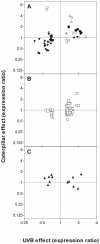Convergent responses to stress. Solar ultraviolet-B radiation and Manduca sexta herbivory elicit overlapping transcriptional responses in field-grown plants of Nicotiana longiflora
- PMID: 12913133
- PMCID: PMC181263
- DOI: 10.1104/pp.103.024323
Convergent responses to stress. Solar ultraviolet-B radiation and Manduca sexta herbivory elicit overlapping transcriptional responses in field-grown plants of Nicotiana longiflora
Abstract
The effects of solar ultraviolet (UV)-B (280-315 nm) on plants have been studied intensively over the last 2 decades in connection with research on the biological impacts of stratospheric ozone depletion. However, the molecular mechanisms that mediate plant responses to solar (ambient) UV-B and their interactions with response mechanisms activated by other stressors remain for the most part unclear. Using a microarray enriched in wound- and insect-responsive sequences, we examined expression responses of 241 genes to ambient UV-B in field-grown plants of Nicotiana longiflora Cav. Approximately 20% of the sequences represented on the array showed differential expression in response to solar UV-B. The expression responses to UV-B had parallels with those elicited by simulated Manduca sexta herbivory. The most obvious similarities were: (a) down-regulation of several photosynthesis-related genes, and (b) up-regulation of genes involved in fatty acid metabolism and oxylipin biosynthesis such as HPL (hydroperoxide lyase), alpha-DIOX (alpha-dioxygenase), LOX (13-lipoxygenase), and AOS (allene oxide synthase). Genes encoding a WRKY transcription factor, a ferredoxin-dependent glutamate-synthase, and several other insect-responsive genes of unknown function were also similarly regulated by UV-B and insect herbivory treatments. Our results suggest that UV-B and caterpillar herbivory activate common regulatory elements and provide a platform for understanding the mechanisms of UV-B impacts on insect herbivory that have been documented in recent field studies.
Figures





Similar articles
-
Solar ultraviolet-B radiation and insect herbivory trigger partially overlapping phenolic responses in Nicotiana attenuata and Nicotiana longiflora.Ann Bot. 2007 Jan;99(1):103-9. doi: 10.1093/aob/mcl226. Ann Bot. 2007. PMID: 17210605 Free PMC article.
-
Molecular interactions between the specialist herbivore Manduca sexta (lepidoptera, sphingidae) and its natural host Nicotiana attenuata. VI. Microarray analysis reveals that most herbivore-specific transcriptional changes are mediated by fatty acid-amino acid conjugates.Plant Physiol. 2003 Apr;131(4):1894-902. doi: 10.1104/pp.102.018184. Plant Physiol. 2003. PMID: 12692348 Free PMC article.
-
Two mitogen-activated protein kinase kinases, MKK1 and MEK2, are involved in wounding- and specialist lepidopteran herbivore Manduca sexta-induced responses in Nicotiana attenuata.J Exp Bot. 2011 Aug;62(12):4355-65. doi: 10.1093/jxb/err162. Epub 2011 May 24. J Exp Bot. 2011. PMID: 21610019 Free PMC article.
-
Ultraviolet-B radiation co-opts defense signaling pathways.Trends Plant Sci. 2003 Nov;8(11):526-33. doi: 10.1016/j.tplants.2003.09.011. Trends Plant Sci. 2003. PMID: 14607097 Review.
-
Terrestrial ecosystems, increased solar ultraviolet radiation, and interactions with other climate change factors.Photochem Photobiol Sci. 2007 Mar;6(3):252-66. doi: 10.1039/b700019g. Epub 2007 Feb 1. Photochem Photobiol Sci. 2007. PMID: 17344961 Review.
Cited by
-
Genome-wide survey and characterization of the WRKY gene family in Populus trichocarpa.Plant Cell Rep. 2012 Jul;31(7):1199-217. doi: 10.1007/s00299-012-1241-0. Epub 2012 Feb 28. Plant Cell Rep. 2012. PMID: 22371255
-
A conserved transcript pattern in response to a specialist and a generalist herbivore.Plant Cell. 2004 Nov;16(11):3132-47. doi: 10.1105/tpc.104.026120. Epub 2004 Oct 19. Plant Cell. 2004. PMID: 15494554 Free PMC article.
-
Remote sensing of future competitors: impacts on plant defenses.Proc Natl Acad Sci U S A. 2006 May 2;103(18):7170-4. doi: 10.1073/pnas.0509805103. Epub 2006 Apr 21. Proc Natl Acad Sci U S A. 2006. PMID: 16632610 Free PMC article.
-
Ultraviolet Radiation From a Plant Perspective: The Plant-Microorganism Context.Front Plant Sci. 2020 Dec 15;11:597642. doi: 10.3389/fpls.2020.597642. eCollection 2020. Front Plant Sci. 2020. PMID: 33384704 Free PMC article. Review.
-
UV-B promotes rapid nuclear translocation of the Arabidopsis UV-B specific signaling component UVR8 and activates its function in the nucleus.Plant Cell. 2007 Aug;19(8):2662-73. doi: 10.1105/tpc.107.053330. Epub 2007 Aug 24. Plant Cell. 2007. PMID: 17720867 Free PMC article.
References
-
- A.-H.-Mackerness S, Butt PJ, Jordan BR, Thomas B (1996) Amelioration of ultraviolet-B-induced down-regulation of mRNA levels for chloroplast proteins, by high irradiance, is mediated by photosynthesis. J Plant Physiol 148: 100–106.
-
- A.-H.-Mackerness S, John CF, Jordan B, Thomas B (2001) Early signaling components in ultraviolet-B responses: distinct roles for different reactive oxygen species and nitric oxide. FEBS Lett 489: 237–242. - PubMed
-
- A.-H.-Mackerness S, Liu LS, Thomas B, Thompson WF, Jordan BR, White MJ (1998) Individual members of the light-harvesting complex II chlorophyll a/b binding protein gene family in pea (Pisum sativum) show differential responses to ultraviolet-B radiation. Physiol Plant 103: 377–384.
-
- A.-H.-Mackerness S, Surplus SL, Blake P, John CF, Buchannan-Wollaston V, Jordan BR, Thomas B (1999) Ultraviolet-B-induced stress and changes in gene expression in Arabidopsis thaliana: role of signalling pathways controlled by jasmonic acid, ethylene and reactive oxygen species. Plant Cell Environ 22: 1413–1423
-
- Allen DJ, Nogués S, Baker NR (1998) Ozone depletion and increased UV-B radiation: is there a real threat to photosynthesis? J Exp Bot 49: 1775–1788
Publication types
MeSH terms
LinkOut - more resources
Full Text Sources
Other Literature Sources
Research Materials

